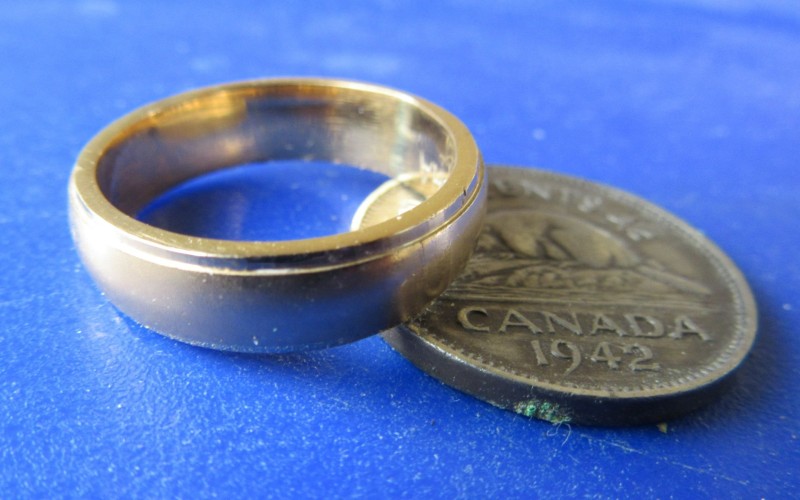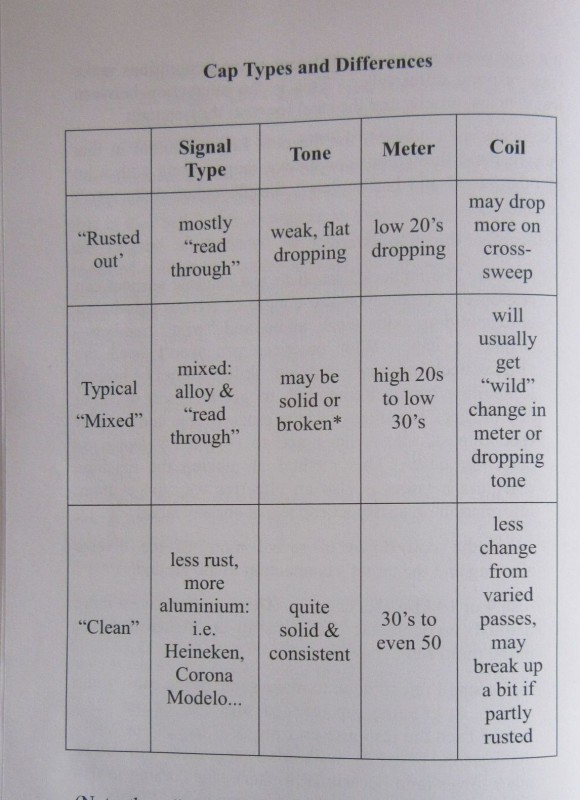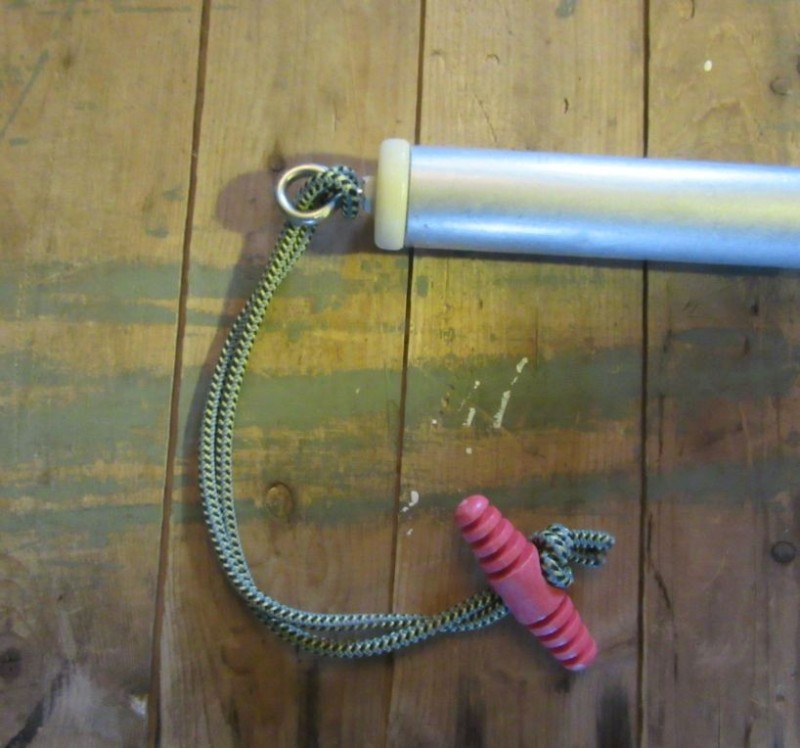-
Posts
514 -
Joined
-
Last visited
-
Days Won
1
Content Type
Forums
Detector Prospector Home
Detector Database
Downloads
Everything posted by cjc
-
Ya, you can tell that it's super loud. He has his T/H super low as well--a good tip. Those micro tuning changes are interesting too. I can't learn enough about this detector -- got a long way to go though... cjc
-
I' ve stoppped wrapping and use Permatech Dielectric Grease to coat everything now. Haven't seen any wasabe yet. Probably a good idea to eyeball everything everry couple of days though... cjc
-
Great run-down video on the capabiles of this machine for anyone wanting to learn more. ton of information here--thanks Alexandre! cjc
-
Sounds rock solid. TDI is certainly all aflutter in fast salt. Cuda though---stikes fast bites deep--anywhere....as advertised😁 Gotta say that even the mighy Dual Field loses depth where there is a lot of interference i.e. fast salt / inclines--just the coil size. I like the AQ though--retunes past all of that nonsense... Jimmy's not the only one with two birds--we agreed that great minds think alike...😁 cjc
-
the whole site is on the Wayback Machine--interesting reading... c
-

Eric Foster Passed Away
cjc replied to Carolina's topic in First Texas - Bounty Hunter, Fisher & Teknetics
Thanks Thomas An amazing service for a well-loved man. Kind Regards clive -
At the same time, the AQ seems okay on big 18k, but it's the Indian people who have the extreme high dollar stuff. There is just too much SS, Tungsten and Titanium around too--worn by those who would have had normal gold. That look like a great mod. I have a modded board of Bill Lahr's that runs 12 uSc--basically a PI Pro with DF coil--killer on all gold and very smooth.--also a prize project. cjc
-
Good point, Carl. I use Permatech Dielectric grease on everything now. Picks up a bit of grit and has to be rinsed / changed periodically but at lease there's no wasabi...everything doesn't have to be wrapped up either--just checked periodically. cjc
-
This is a machine that's a dramatic departure from anythig else out there--closest being the TDI Pro. I have two and plan to keep them in that they do things no other machine will. I like the smoothness, target information and overall audio. The optimization is also great too--it loves the high foils and so do I 😁. This is how I try and set up any machine I use. If you have some awareness of the concepts of "carry" and "correlation" and stay off the wide, responses, the discrimination is helpfull. (I would use a stronger word--but Im still learning). You are probably better off running in All Metal, for the added depth. This requires a bit of PI skill. I do wish that it responded better to big 22k but running A/M does offset this a bit. Yes there have been build issues but nothing insurmountable. In particular the Vishay pots are problematic--maybe the 14.4 is too hot for them in that the T/H seems to be particulary vulnerable to frying out. I've had several replaced. In the environment I hunt, (Equinox "troll" under every bridge, lol) this machine is exactly the edge I need. A few years back my accuracy with the NOX gave me a big advantage, but now I need that same accuracy with even more depth and black sand capabily. While I'm still developing my accuracy with this machine-there's no queston that the potential is there. Here is a nice end-of-season 22k band find from a section that has just been trampled over 8 months by other hunters--the AQ went down about 18" to bring up a response. This is a machine that can go in after anything--save for the TDI--another very deep detector. There is nothing wrong with the Limited, just needs a bit of extra carefulness around the "tailfeathers." cjc
-

AQ Coil Questions
cjc replied to stateguy's topic in First Texas - Bounty Hunter, Fisher & Teknetics
I can't speak to the shallow target responses--just not what I've tested. If you secure your cable lighlty using the sock clips or a tied eleastic, there's no need to worry about the coil hardware being pulled. I would avoid wrapping the cable though, the positon of the hardware would be pulled when you press on the heel of the coil. Like the TDI this is a machine that takes time to learn. Im continually testing mine and this is paying off. Try turning the Gain up indoors to get an idea of how essential signal balancing is with this machine. You can also get more depth my slowing down the retuning slightly but this offsets your abillity to hear the wide response of caps. cjc -
Well said, Steve. He was very central to Fisher--the "point man" if you will. I just thought that merited an announcement. Kind Regards clive
-
Surprised to hear that Felix is no longer with FT. I've known Felix for 40 years + a great source of information I will miss his accurate and detailed approach to his work. The FT detectors have always been very solid and thanks in part to Felix they do back them up with great service. Wishing him well in nis new endevours. cjc
-

Minelab Manticore Unofficial Specs And Features Thread
cjc replied to Chase Goldman's topic in Minelab Manticore Forum
...almost like an XLT... cjc -
Cancun--a bit lawless for my tastes these days--probably okay though. Its true, Minelab have been inovators and the R&D has paid off but I have to say that with the NOX (a machine I've had good sucess with) M/L's smuggness surrounding the leaks has put me off them as an organization. (I'm on my fourth brain--the last of which I've had to buy). If success translates into a lack of humility--I'll take mediocre. This whole "only .4% leak" line is horseshit--my experence alone negates it. Same with the CTX--even after the bulkhead was changed, I can't run this machine with a lilthium cell as I've just thrown so many away--at $200 a pop. These guys acted as if they were doing me a huge favor by standing behind their $3000 product. And as you said--"me of all people"--studying these products and trying to teach others these specific types of equipment handling tricks and safety measures. How many of my (otherwise well planned) trips have these two detectors ruined? Quite a few . I also disliked this whole "army of yes-men" enviroment that surrounded the NOX when it came out. I've seen the face of a new hunter who has come out from his first water hunt to see a screen full of water. Also even with all the implicit advertising and promotion I've contributed by teaching others how to get the most from their products (and avoid needless warantee repars) this organization has always treated me like a "prevailing wind" --selecting guys with a few year's experience over me to be brand ambassadors. (Not that I care to be one at this point). It's my job to "call em like I see em"--maybe that's why. It's funny--my competitor promotes that his books are "factory authorized" --I promote that mine arent...I write about the whole detector--good and bad--turns out thats what you end up dealing with in the field, hmmm? My readers expect more from me than "ra, ra." It's also why I hang out here--Im not the only one who tells it like it is. I'll spit out one more saying: "better to have questions to which there arn't any answers than answers to which there aren't any questons." Regards clive
- 23 replies
-
- 12
-

-
Certainly sounds like a good machine but nobody rides on their laurels in my world... This whole "if I know Minelab" line of reasoning does not take me very far. It''s like the guy who says he is having converstations with bigfoot (speaking of beasts): "extrordinary claims require extrordinary proof." cjc
-
A Few Notes on the Nokta / Makro Legend by Clive James Clynick The first thing I noticed about the Legend was it’s processing. Like the Anfibio—this processing makes for super clean audio in iron or dense trash. With the Legend however, this processing is fast and detailed enough to mediate multiple frequencies at once. This means that both the audio and meter information is more accurate as these frequencies cross confirm. As with any multi frequenciy machine, these frequencies examine the ground in different ways—making detection very thorough and deep. The Legend’s processing does two things: 1/ I immediately noticed how well this machine “pulls” up responses in dense trash or iron. Particularly in the multi-tone modes (6 and 60) these signals are reported very cleanly. 2/ This accurate processing reports the quality of responses well. What I mean by this is that targets that are rusted, made of diverse alloys or odd shaped such as “can slaw” sound rough whereas something made of fewer metals or a round object will give a cleaner, more solid tone. This is a great operationg characeristic–especially for beginners–helping you to focus on good qualtiy signals. Also, weak conductors such as thin foils sound weak—that is, they don’t sound more solid than they are. This is especially important when searching for small gold. This strong multi-frequency processing also means that simple target testing is very effective. So when you want to know what size or shape a target is—or how consistent it is—tests like using varied sweep speeds and directions will give you a lot of audio and meter information. Also, where you see big meter jumps—these are highly meaningful—indicating a poor quality signal or something odd-shaped. Pinpoint mode also gives good information on whether something has the sharp, narrow tone of a non-ferrous target—or the wide, drawn-out tone of iron. This effectiveness comes from the Legend’s high “resolution”–that is—the accurate processing of the multiple frequencies gives a lot of detail on what is under the coil. This is also a detector with a lot of fidelity. You have the option of running multi frequency—or any of the single ones to bring up specific target ranges and examine the ground from a number of standpoints. The machine can be run fast or slow with high or low Iron Bias. This adjustable iron filtering is by far the most important feature of the v. 1.09 upgrade. What this means is that in dense junk or iron you have the choice of trying to speed up and bring up the “cleanest” responses–or to slow down and use the Legend’s processing to saturate what’s under the coil more and bring up tones one what you are looking for. These types of settings examine the ground in very specific ways letting you return to heavily worked prime ground with never before tried search methods. There are some remarkable videos out of the Legend’s low bias settings “seeing through” multiple spikes to bring up a tone on silver—as if the iron was not even there. I’ve also had to opportunity to run the Legend at a tough, high-saline ocean beach. It performed well and even had great audio in nail infested sections—giving longer tones on non-ferrous targets that were mixed in. This audio processing was so accurate that the Legend even distinguished stainless steel from iron. The Legends clean, sharp audio and tone menu choices are great tools to help at these tough sites. The v. 1.09 upgrade offers new audio preference choices including VCO (Pitch Audio), and Boost. These are some of the great performance characteristics that I’ve noticed about the Legend in my first season of hunting with it. I highly recommend this great detector for hunters at any level of the hobby. Good Luck Detecting, clive
-

The Legend Removes Beer Bottle Caps
cjc replied to Jason China's topic in Nokta / Makro Legend Forum
caps force you to learn a bit more theory. Most caps are more like the ground than a good target and can be recognised by this feature. use your cross sweep and look for the "wild" response. Also try combining this technique with 60 Tone audio. See illustration below from my book. cjc -

50% More Power To The Manticore Coil?
cjc replied to Erik Oostra's topic in Metal Detector Advice & Comparisons
Well a machine like the Anfibio can be tested indoors and the stability is unreal. As for these claims about the Mantacore--seems to play on what they hope is the limited knowledge of many consumers in that how much power is being transmitted is only part of the equasion. What the conditions will allow is the rest..kinda like depth claims that omit the variable of "where?" cjc 😁 -

Minelab Manticore Unofficial Specs And Features Thread
cjc replied to Chase Goldman's topic in Minelab Manticore Forum
Ya, very important for new hunters to understand how to mediate this bottom "rust line" / foils range--something I've tried to addresss in my books. Things like hairpins and stainless rings are actually good teachers. Also, seem to remember that the old DFX had some kind of ID Sensitivity control to mediate "splattter". Just goes to show how far ahead of their time the XLT and DFX were. LIkely the Mantacore wont need it owing to the more precise processing. At the same time, this "splatter" represents a lot of valuable information--one of my best dense trash gold tricksl with the Anfibio. It alerts you to alloys, steel, and oversize targets that the machine is reading part of. Thanks for your informative post as always, Steve. cjc -

Minelab Manticore Unofficial Specs And Features Thread
cjc replied to Chase Goldman's topic in Minelab Manticore Forum
...very little feedback...but a lot of random noise.... cjc -

Minelab Manticore Unofficial Specs And Features Thread
cjc replied to Chase Goldman's topic in Minelab Manticore Forum
Ya that mixed mode was remarklable on the small gold. The 100+ and minus was amazing too --it had enough room to tell you what was what but was still stable. Where it got a bit confusing though was with the whole normalization thing. Also when you saw that 14-16 it was almost always small gold--never seen a detector with this level of conclusiveness before or since. cjc -

Impulse AQ Testing Results
cjc replied to cjc's topic in First Texas - Bounty Hunter, Fisher & Teknetics
I would also say that with all of its threaded aluminum surfaces (and slightly dodgey coil connector) a tube of Permatech Dielectric Grease is a must. Apply with a toothbrush to all co-axe jacks and pins--hopefully this will prevent any "wasabe' from showing up. and the jacks turning properly. cjc






